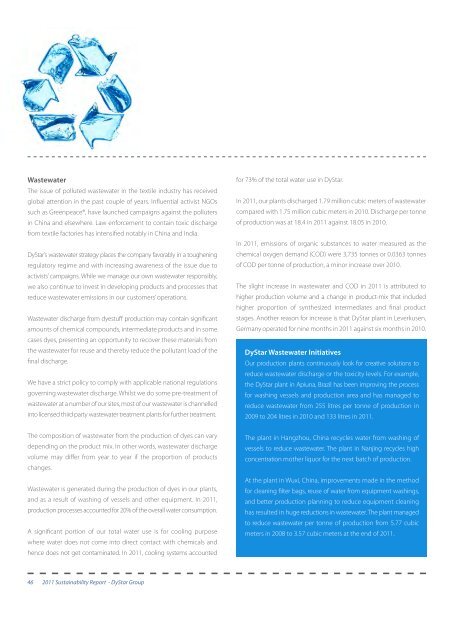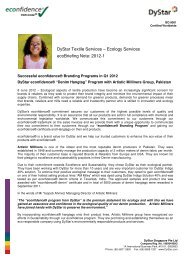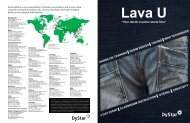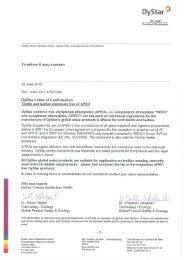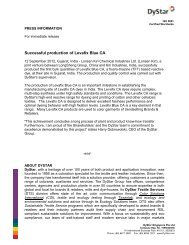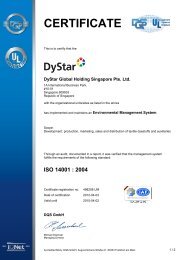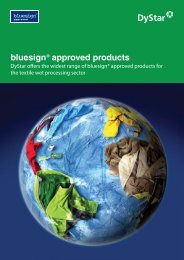Read the DyStar Sustainability Report 2011...
Read the DyStar Sustainability Report 2011...
Read the DyStar Sustainability Report 2011...
Create successful ePaper yourself
Turn your PDF publications into a flip-book with our unique Google optimized e-Paper software.
Wastewater<br />
The issue of polluted wastewater in <strong>the</strong> textile industry has received<br />
global attention in <strong>the</strong> past couple of years. Influential activist NGOs<br />
such as Greenpeace®, have launched campaigns against <strong>the</strong> polluters<br />
in China and elsewhere. Law enforcement to contain toxic discharge<br />
from textile factories has intensified notably in China and India.<br />
<strong>DyStar</strong>’s wastewater strategy places <strong>the</strong> company favorably in a toughening<br />
regulatory regime and with increasing awareness of <strong>the</strong> issue due to<br />
activists’ campaigns. While we manage our own wastewater responsibly,<br />
we also continue to invest in developing products and processes that<br />
reduce wastewater emissions in our customers’ operations.<br />
Wastewater discharge from dyestuff production may contain significant<br />
amounts of chemical compounds, intermediate products and in some<br />
cases dyes, presenting an opportunity to recover <strong>the</strong>se materials from<br />
<strong>the</strong> wastewater for reuse and <strong>the</strong>reby reduce <strong>the</strong> pollutant load of <strong>the</strong><br />
final discharge.<br />
We have a strict policy to comply with applicable national regulations<br />
governing wastewater discharge. Whilst we do some pre-treatment of<br />
wastewater at a number of our sites, most of our wastewater is channelled<br />
into licensed third party wastewater treatment plants for fur<strong>the</strong>r treatment.<br />
The composition of wastewater from <strong>the</strong> production of dyes can vary<br />
depending on <strong>the</strong> product mix. In o<strong>the</strong>r words, wastewater discharge<br />
volume may differ from year to year if <strong>the</strong> proportion of products<br />
changes.<br />
Wastewater is generated during <strong>the</strong> production of dyes in our plants,<br />
and as a result of washing of vessels and o<strong>the</strong>r equipment. In 2011,<br />
production processes accounted for 20% of <strong>the</strong> overall water consumption.<br />
A significant portion of our total water use is for cooling purpose<br />
where water does not come into direct contact with chemicals and<br />
hence does not get contaminated. In 2011, cooling systems accounted<br />
46 2011 <strong>Sustainability</strong> <strong>Report</strong> - <strong>DyStar</strong> Group<br />
for 73% of <strong>the</strong> total water use in <strong>DyStar</strong>.<br />
In 2011, our plants discharged 1.79 million cubic meters of wastewater<br />
compared with 1.75 million cubic meters in 2010. Discharge per tonne<br />
of production was at 18.4 in 2011 against 18.05 in 2010.<br />
In 2011, emissions of organic substances to water measured as <strong>the</strong><br />
chemical oxygen demand (COD) were 3,735 tonnes or 0.0363 tonnes<br />
of COD per tonne of production, a minor increase over 2010.<br />
The slight increase in wastewater and COD in 2011 is attributed to<br />
higher production volume and a change in product-mix that included<br />
higher proportion of syn<strong>the</strong>sized intermediates and final product<br />
stages. Ano<strong>the</strong>r reason for increase is that <strong>DyStar</strong> plant in Leverkusen,<br />
Germany operated for nine months in 2011 against six months in 2010.<br />
<strong>DyStar</strong> Wastewater Initiatives<br />
Our production plants continuously look for creative solutions to<br />
reduce wastewater discharge or <strong>the</strong> toxicity levels. For example,<br />
<strong>the</strong> <strong>DyStar</strong> plant in Apiuna, Brazil has been improving <strong>the</strong> process<br />
for washing vessels and production area and has managed to<br />
reduce wastewater from 255 litres per tonne of production in<br />
2009 to 204 litres in 2010 and 133 litres in <strong>2011.</strong><br />
The plant in Hangzhou, China recycles water from washing of<br />
vessels to reduce wastewater. The plant in Nanjing recycles high<br />
concentration mo<strong>the</strong>r liquor for <strong>the</strong> next batch of production.<br />
At <strong>the</strong> plant in Wuxi, China, improvements made in <strong>the</strong> method<br />
for cleaning filter bags, reuse of water from equipment washings,<br />
and better production planning to reduce equipment cleaning<br />
has resulted in huge reductions in wastewater. The plant managed<br />
to reduce wastewater per tonne of production from 5.77 cubic<br />
meters in 2008 to 3.57 cubic meters at <strong>the</strong> end of <strong>2011.</strong>


